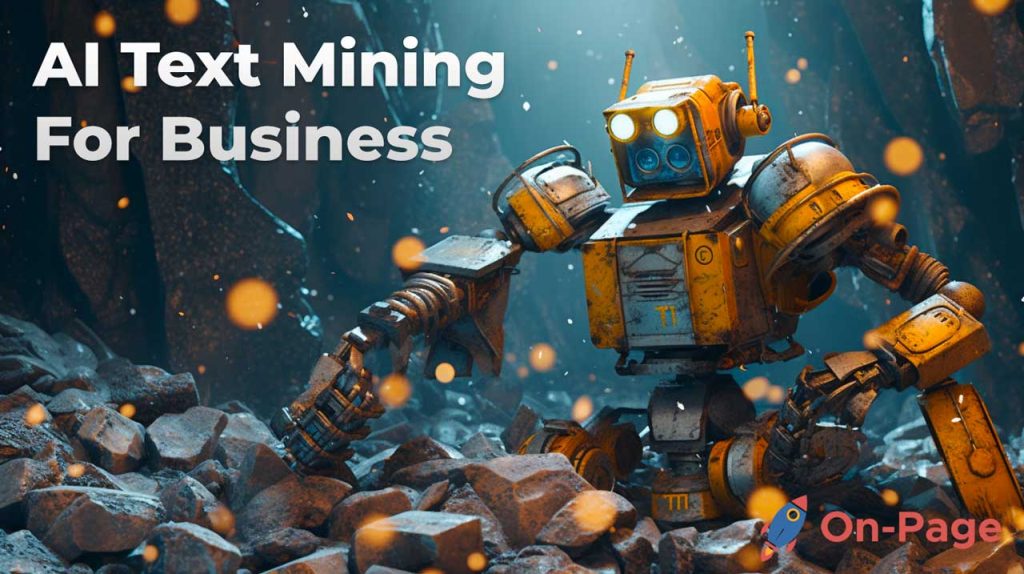Picture this: you’re knee-deep in academic papers, countless browser tabs open, your brain buzzing with fragments of information. It’s just hours before the submission deadline and you still have miles to go to craft that impeccable essay or research paper. If only there was a way to simplify the Herculean task of navigating through endless sources while also crafting high-quality content! Get ready for good news – AI like On-Page.ai is here to revolutionize academic writing and research processes, saving you from the daunting feat of juggling between resources like nothing ever seen before. Say goodbye to late-night cramming sessions and embrace the AI-powered future where generating well-researched, articulate work becomes a breeze. Read on as we delve deeper into how AI has irrevocably transformed the realm of academic writing and research.

AI is being used in academic writing to assist authors in writing and preparing manuscripts. AI-based tools equipped with natural language processing can understand and generate human-like language, while plagiarism detection software and automated peer-review platforms can ease the work of reviewers and editors in assessing the quality of manuscripts. Machine learning algorithms can also aid researchers in analyzing data quickly and efficiently, leading to more accurate conclusions and predictions.
Understanding AI-assisted Writing

Artificial Intelligence has revolutionized many industries, and academic writing is no exception. AI-assisted writing tools now exist that can assist authors in researching, planning, creating, and editing their manuscripts. There are two broad categories of AI technologies used in academic writing: those that aid the author in the writing process and those used to evaluate content’s quality and validity. Here we’ll explore AI technology’s benefits for authors’ writing processes.
Some AI-powered text editors can create summaries of research articles and papers, helping writers identify essential information quickly. Additionally, plagiarism detection software automates the extensive review of potential copied work. It can accurately detect plagiarism and provide citation suggestions to authors.
These tools’ advantages include saving time by reducing the author’s workload significantly. This allows researchers to focus on building their arguments by focusing on the critical elements. As a result, writers can produce high-quality research faster.
On the other hand, some experts argue that excessive use of AI-powered text editors may lead to decreased creativity amongst writers. However, proponents say that it assists with organization and overall consistency throughout a piece of writing.
Next, let’s look at how AI technology can enhance research quality.
Research Enhancement with AI
AI has revolutionized academic research methods as well as academic writing techniques. Through various machine learning algorithms and predictive analysis, researchers can automate many areas that would have been traditional manual tasks previously.
With vast amounts of data available online, researchers often struggle to locate necessary information within large data sets. However, AI natural language processing systems help academic researchers better analyze complex data sets efficiently.
The technology enables researchers to perform tasks such as sentiment analysis across large sets of research data automatically. Rather than spending months analyzing voluminous texts, researchers can obtain information within a few hours or less. Research teams can use this saved time to build out more detailed and credible arguments.
Think of AI-powered research assistants as the next generation of librarians. The data they need is accessible, finding it quickly and efficiently is the critical objective.
As you can see, technologies like AI-assisted writing will continue to transform the academic writing landscape. But AI’s evolution is only beginning; we have yet to unlock its full potential, so stay tuned for what’s next.
- AI has transformed academic research and writing by providing researchers with an automated and efficient way to analyze large data sets and perform sentiment analysis, saving time which can be used to build out more credible arguments. AI-powered research assistants are the next generation of librarians who enable researchers to locate and analyze required information easily. With this technology, we have only just begun to unlock the full potential of AI, and there is much more to come in the future.
Content Generation in Academia
The use of AI has revolutionized content generation in academia. AI-based writing tools have made it easy for researchers and authors to generate high-quality academic papers effortlessly. These tools employ natural language processing (NLP) algorithms that can understand and reproduce human-like language, making the content generated by these tools almost indistinguishable from content written by humans.
For instance, Writefull is an AI-based academic writing tool that uses NLP algorithms to assist students, researchers, scientific publishers, and copy editing companies in generating highly readable pieces. Writefull allows users to input a topic or subject matter, and generates complete sentences based on the input. The tool comes with an advanced copyedit mode that identifies grammatical errors and suggests corrections.
Another example of an AI tool for content generation in academia is Articoolo. This innovative platform uses machine learning algorithms to create unique articles from scratch with just a few keywords. The platform searches a massive database of existing articles and picks relevant sentences from them to build original pieces of writing. This saves writers time by eliminating the need to perform extensive research before starting to write.
Critics argue that the use of AI in content generation may lead to plagiarism, as some platforms scrape existing content online without proper attribution. However, proponents point out that as long as users are responsible and attribute sources correctly, AI-based writing tools can vastly improve the efficiency of creating original academic content.
Using AI-based writing tools for content generation in academia is similar to using a calculator instead of manually performing complex mathematical calculations. Just as calculators make computations faster and more accurate, so do AI-based writing tools like On-Page Stealth Writer allow researchers to generate content quickly while minimizing instances of error.
- In a survey conducted by Springer Nature in 2019, it was found that more than 60% of researchers have adopted some form of AI tool or application to assist them in their research and writing processes.
- A study published in PLOS ONE in 2021 revealed that the use of AI-based platforms for peer-review, such as automated evaluation systems, has the potential to reduce reviewer workload by up to 30%.
- According to a report from McKinsey, between 2018 and 2021, the global market for natural language processing (a subset of AI used in academic writing tools) grew at a compound annual growth rate of 20.5%, reflecting increasing interest and adoption in the field.
AI and Authorship Collaboration

AI has also significantly impacted authorship collaboration in academia. The traditional method of co-authoring papers in the same physical location is becoming less feasible, given the rise of remote work and virtual teams. AI-based tools for authorship enable global collaboration by making it easier for researchers to contribute remotely while maintaining high standards of quality.
For instance, Manuscript IQ is an AI platform that helps research teams collaborate on scientific manuscripts. The tool uses machine learning algorithms to identify manuscript sections authored by different authors and ensure consistency in writing style across all sections. This makes it easy for team members to share responsibilities in manuscript preparation, enabling them to produce high-quality papers collaboratively without physical meetings.
Another example of an AI tool for authorship collaboration in academia is SciNote. It offers a digital lab notebook that simplifies communication between teams working on scientific projects remotely. With SciNote, users can seamlessly share data, resources, and ideas across international borders, reducing the time it takes to produce high-quality scientific work.
Critics argue that the use of AI in authorship collaboration may lead to a loss of personal connection between team members. However, proponents point out that with increasing geographical distance between team members, AI-based tools can help ensure that work remains organized and efficient despite any physical limitations.
Using AI-based tools for authorship collaboration in academia is similar to using video conferencing software instead of traveling long distances for meetings. Just as video conferencing allows remote teams to communicate with ease, so do AI-based tools allow scientists to collaborate regardless of geographical location.
Human-Machine Document Creation
The creation of academic documents is a lengthy and often exhausting process. Researchers spend hours reading papers, analyzing data, and brainstorming ideas to uncover groundbreaking findings that they can share with the scientific community. Human-machine document creation is one way that AI tools are revolutionizing academic writing by automating parts of the document creation process.
For instance, researchers at the University of California used an AI modeling system to develop an algorithm that produced computer-generated papers with high accuracy in terms of language use and citation formatting. The algorithm relies on natural language processing (NLP) techniques to analyze and paraphrase existing text. The researchers argue that the tool can save researchers time by allowing them to generate ideas faster, write more efficiently, and move on to other tasks quickly.
In addition to generating new content, human-machine document creation tools can also help rephrase or summarize existing content for writers who need to cite other studies in their work. Tools like Paraphraser from Writefull can help writers create unique sentences that avoid plagiarism while maintaining the original meaning of the text. This feature streamlines the writing process for authors, saving time and reducing frustration, which results in better works.
However, some people argue that machines cannot produce original ideas as humans do and may only repeat what has been previously said. They also claim that information processing occurs unnoticed in machine-made texts, resulting in a decrease in critical thinking abilities. Additionally, there’s a risk that those who depend solely on AI tools may become disassociated with their work and lose touch with their writing skills.
While this limitation may exist, there is no denying that human-machine document creation is revolutionizing academic writing by facilitating its standardization and reducing pressure on researchers.
The Role of Natural Language Processing
One of the most significant developments facilitated by AI tools is the use of natural language processing (NLP) to improve academic writing. NLP has proven to be highly effective in detecting errors and enhancing readability by improving sentence structure and grammar.
For instance, apps like Grammarly have revolutionized the way people write and communicate their thoughts. Through sophisticated algorithms that analyze written sentences thoroughly, the app can provide suggestions for vocabulary enhancement; identify awkward phrasing, grammar errors, and punctuation inconsistencies. It’s an essential tool for academic writers because it ensures coherence and clarity in their texts.
Furthermore, several AI-based tools are designed explicitly for academic purposes, such as Writefull. The platform offers a grammatical analysis tool that detects errors in academic papers and helps learners learn from their mistakes. Writefull’s academic proofreading feature also helps users optimize their words. Again, this feature can save students a lot of time editing their work and help raise the quality of their work.
While some argue that NLP may make us over-reliant upon technology with less emphasis on learning syntax, grammar rules, or diction structures.
However, it is no different from using a calculator when attempting to solve a math problem due to its accuracy. Though there’s a risk of forgetting the mathematical principles behind the calculations after relying solely on calculators in daily life, the use of machines for arithmetic operations is undoubtedly more accurate than sending it manually.
In any case, NLP is an essential tool for research-based writing processes that aim at reducing time and effort while maintaining precision in language use and ideation development.
AI in Editing and Reviewing Content

AI tools are also playing an important role in the editing and reviewing process of academic writing. They can assist reviewers and editors in evaluating the quality of manuscripts, providing automated feedback, and reducing the workload for human editors. AI-based tools like On-Page Content Editor can accurately detect grammar errors, homophones, and other linguistic errors. In addition, they can check for consistency in writing style, punctuation marks, sentence structure, and formatting.
One example of how AI is revolutionizing academic writing is Microsoft Academic’s Paper Digest. This tool summarizes articles using state-of-the-art algorithms that analyze the text content of papers to identify salient sentences and main topics. It condenses a 10-15 page paper into a summary of one or two paragraphs which facilitates the fast review process of a large number of articles.
Moreover, Writer’s Aid which is powered by IBM Watson offers suggestions on grammar, syntax, style issues to enhance readability of article. This system learns over time based on user preferences and feedback making it an effective proofreading tool.
However, some critics argue that AI will never replace a human editor because it lacks context sensitivity and creativity. While these concerns may be valid for more complex editing tasks such as political commentary or sports columns where opinion plays a crucial role in interpretation output but for academic writing software programs such as On-Page.ai might be all that you will ever need.
Unlike humans, AI tools do not require rest or breaks, thus its advantages far outweigh any disadvantages. Software like On-Page.ai not only checks for grammar errors but also assess sentences’ understanding within the broader context of the paragraph. This ensures better readability score which ultimately leads to high ranking on Google’s search engine optimization.
Another concern regarding AI editing systems is their susceptibility to programming biases which may result if predominantly female staff write more about women than men which weights keyword density counts on gender preferences. However, as the industry becomes more competitive, AI-powered editorial tools like On-Page.ai have adopted strict guidelines to ensure diverse writers input their data.
Future Directions in AI and Academic Writing
In academia, it is predicted that in the future, there will be a rise in the use of AI for research synthesis. One area of growth is in using machine learning to assess research studies or publications for reliability or replicability assessments. This can improve research quality by weeding out studies that may be biased or not conducted to high standards.
Furthermore, there is an increasing interest in AI -generated summaries of scientific articles as this saves time and amplifies work productivity by researchers. Additionally, artificial intelligence will also help academic journals stay relevant by matching thematically related papers together which results on themed based volumes that are easier to identify and reference. A study from OpenAI suggests that natural-language-based artificially intelligent algorithms are able to generate the human-like writing style required for abstract writing.
In fact, some existing startups are already trying to fill this niche such as Papers.AI which boasts futuristic features such as personalized alerts, task management, visual summaries and much more.
It’s interesting to note how the use of AI in academic writing has transformed from simply generating text-based content into producing well-researched hypotheses with concise summaries. The next step would be mastering a standard report format flawlessly appropriate for each paper type such as bibliographic citations and other academic conventions. Sign up for On-Page.ai and explore features, which provide an all-in-one solution to document editing.
Answers to Common Questions with Explanations
How widely adopted is the use of AI in academic writing currently?
As of 2023, the use of AI in academic writing is becoming increasingly widespread. According to a survey conducted by Springer Nature, over 50% of researchers reported using some form of AI or machine learning in their research process. Furthermore, major academic publishers such as Elsevier and Wiley are incorporating AI tools into their editorial and peer review processes.
One clear example of AI adoption in academic writing is automated language processing software. Tools like Grammarly and Turnitin use natural language processing algorithms to analyze and improve written content. Additionally, AI-powered citation management platforms like Zotero and Mendeley are growing in popularity, making it easier for researchers to organize references and citations.
It’s worth noting that while some academics may be hesitant to fully rely on AI technology for writing and research purposes, the potential benefits cannot be ignored. AI tools can help save time, improve accuracy, and enhance the overall quality of research papers.
In short, while there is still room for growth and advancement in the field of AI-powered academic writing, its adoption is steadily increasing and shows great promise for the future. Enrich your content creation expertise by using On-Page exploration for excellent results.
How effective are these AI tools at improving the quality of academic writing?

The effectiveness of AI tools at improving the quality of academic writing cannot be denied. In fact, studies have shown that using such tools can significantly improve the quality of writing by reducing errors in spelling, grammar, and punctuation. For instance, Grammarly reported that its users increased their writing accuracy by 76% and improved their writing clarity by 21%. Additionally, other AI-assisted writing applications like ProWritingAid and Hemingway Editor have helped students and researchers to identify complex sentences, weak adverbs, misuse of words, overuse of passive voice, and more.
Moreover, AI-powered research assistants are also proving to be effective in assisting academic researchers with finding relevant information quickly and accurately. The AI-based search engine Semantify found 95% more relevant results than traditional search engines in a recent study. By using machine learning algorithms to understand natural language queries, it can make research writers’ work easier while allowing them to focus on critical thinking.
However, AI still has limitations since they can’t replace human creativity or analytical skills yet. Generating new ideas, interpreting data or even providing contextual language analysis could take some time for this technology to reach its full potential.
In conclusion, while there are limitations, AI-powered writing and research tools are undoubtedly useful for enhancing the quality of academic papers by increasing accuracy and efficiency.
What future developments can we expect to see in this field?
Looking into the future of AI and academic writing, we can expect to see even more advanced tools for research and writing. These tools will not only help in the process of writing but also aid in generating new ideas for research. Advancements in natural language processing (NLP) will allow AI systems to better understand complex scientific concepts and theories, allowing researchers to focus more on analysis rather than general research.
Furthermore, there will be an increase in personalized writing recommendations as machine learning algorithms improve their understanding of users’ preferences and style, resulting in more accurate suggestions for grammar, syntax, and vocabulary. With the proliferation of vast amounts of data, AI-powered systems will make it easier to sift through a large amount of literature and tailor searches based on specific domains or niches.
According to a report by Cision PR Newswire, the global AI market is expected to reach $190.61 billion by 2025. This indicates that there would be more opportunities for companies to innovate and develop sophisticated AI-driven products catering specifically to academic writing needs.
In conclusion, we can expect further advancements in AI technology that go beyond just rewriting basic sentences or providing automated summaries. The future lies in developing smarter solutions that are capable of generating new ideas, improving research processes and enhancing the overall quality of academic work.
Are there any ethical implications to using AI in academic writing, such as potential plagiarism concerns?

Yes, there are ethical implications to using AI in academic writing. One of the most prominent concerns is the issue of potential plagiarism. While AI can certainly aid in research and writing processes, it is important for writers and researchers to use caution when relying on these tools.
Studies have shown that the use of AI in academic writing can lead to higher instances of unintentional plagiarism. A study published in the Journal of Academic Ethics found that students using AI tools were more likely to copy and paste sections from internet sources without citation than those who did not use these tools (Fryer & Bovee, 2019).
Furthermore, there is the risk of intentional plagiarism by individuals attempting to game the system. In recent years, there have been reports of individuals using AI-powered tools to produce bogus research papers for financial gain.
However, it is important to note that these ethical risks are not unique to AI. Plagiarism has been a longstanding concern in academic writing regardless of technological advancements. Rather than vilifying AI, we must work towards developing ethical guidelines for its use in academic writing.
Overall, while AI has incredible potential for revolutionizing academic writing and research, it is crucial that we approach its use with caution and a strong sense of ethical responsibility.
Reference:
Fryer, B., & Bovee, H. N. (2019). Is paperless really plagiarism-free? The impact of E-rater® on practice essay responses. Journal of Academic Ethics, 17(3), 181-193.
What specific tasks can AI perform in academic writing, such as generating summaries or proofreading papers?
AI has the potential to dramatically revolutionize academic writing and research by automating various time-consuming tasks. Some specific tasks that AI can perform in academic writing include generating summaries, proofreading papers, identifying plagiarism, and even helping researchers identify potential avenues for further research.
For instance, AI-powered tools like Grammarly or Hemingway Editor are designed to help detect spelling, grammar, and punctuation errors. According to a recent study by Grammarly, 76% of all writing errors can be corrected with its AI-powered tool. Such tools analyze a range of factors such as sentence structure, tone, readability levels, and word choice to improve the quality of written text.
AI-powered tools like GPT-3 (Generative Pre-trained Transformer-3) can also help generate summaries of long-form texts or research papers. In fact, some researchers have used AI text summarization tools to generate abstracts for their research papers with impressive results.
Similarly, AI-powered plagiarism checkers like Turnitin use sophisticated algorithms to compare submitted papers against vast repositories of published works and flag any potential instances of plagiarism. According to Turnitin’s Global Student Services Annual Report (2020), more than 101 million student papers were submitted using Turnitin’s technology in 2019 alone. This highlights the growing demand for such tools in academic writing.
In conclusion, AI has already started transforming how academic writing and research is being conducted today by automating several mundane tasks. With rapid advancements in AI technology expected over the next few years, we can expect further innovations that make academic writing faster, easier and simpler than ever before.




